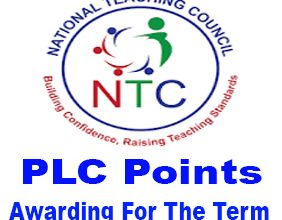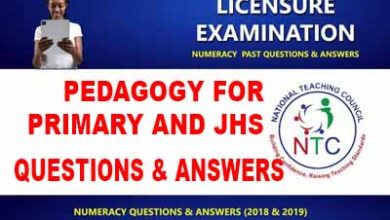Content Areas For SHS Pedagogy For NTC Exams September 2023 Questions And Answers
SHS Pedagogy Questions And Answers
THE CONCEPTS OF METHODOLOGY IN TEACHING SECONDARY SCHOOL
Methodology in teaching secondary school refers to the strategies, techniques, and approaches used by teachers to facilitate effective learning and instruction in a secondary school setting. It involves a systematic and organized approach to planning, delivering, and assessing lessons to meet the educational needs of students at the secondary level. Here are some key aspects of methodology in teaching secondary school:
Methodology refers to the set of principles, tools, and practices used to conduct research or investigations in a particular field of study or discipline1. It can be thought of as the systematic approach used to collect and analyze data for a specific research question or hypothesis.
The concepts of methodology refer to the systematic approach or set of principles used to conduct research or solve problems in various fields of study.
Methodology provides a framework for organizing and conducting research, gathering and analysing data, and drawing conclusions or making decisions based on the findings. It involves the selection of appropriate research methods, data collection techniques, data analysis procedures, and interpretation of results.
TYPES OF METHODOLOGY IN TEACHING SECONDARY SCHOOL AND EXAMPLE
- Direct Instruction: This methodology involves explicit teaching and structured delivery of information by the teacher. It typically includes lectures, demonstrations, and guided practice, with a focus on clear explanations and step-by-step instructions.
Example. In a biology class, the teacher provides a structured lecture on the process of photosynthesis, explaining the step-by-step process, highlighting key concepts, and providing examples to illustrate the concept.
- Inquiry-Based Learning: This approach promotes student-centered learning and critical thinking skills. Students explore questions, problems, or scenarios through investigation, analysis, and reflection. They actively construct their understanding of concepts and develop problem-solving abilities.
Example: In a physics class, students are given the task of designing and conducting an experiment to investigate the relationship between the length of a pendulum and its period of oscillation. They formulate hypotheses, gather data, analyze results, and draw conclusions based on their investigations
- Cooperative Learning: This methodology emphasizes collaboration and group work. Students work together in small groups to achieve learning goals, engage in discussions, share ideas, solve problems, and complete projects. Cooperative learning fosters teamwork, communication, and the development of social skills.
Example: Cooperative Learning: In a literature class, students work in small groups to analyze a novel and collectively create a dramatic presentation. Each group member takes on a specific role, such as a character, narrator, or director, and collaborates to bring the story to life through their performance.
- Problem-Based Learning: In this methodology, students learn through solving real-world problems or challenges. They apply their knowledge and skills to analyze, research, propose solutions, and present their findings. Problem-based learning enhances critical thinking, creativity, and problem-solving abilities.
Example:: In a mathematics class, students are presented with a real-life scenario, such as planning a school event within a budget. They work in teams to calculate costs, allocate resources, and develop a detailed plan to organize the event while adhering to budget constraints.
- Project-Based Learning: Similar to problem-based learning, project-based learning involves students working on extended projects or investigations. They engage in hands-on activities, research, and create tangible outcomes, such as presentations, models, or reports. This methodology promotes collaboration, self-directed learning, and the application of knowledge in authentic contexts.
Examples: In a history class, students undertake a project to create a documentary on a specific historical event. They conduct research, gather primary and secondary sources, interview experts, and compile their findings into a multimedia presentation that presents a comprehensive understanding of the chosen historical event.
- Differentiated Instruction: This approach recognizes the diverse learning needs and abilities of students. Teachers adapt their instruction, materials, and assessments to accommodate different learning styles, interests, and readiness levels. Differentiated instruction allows students to access content at their own pace and supports individual growth.
Example: In an English class, the teacher provides a variety of reading materials on the same topic or theme, catering to different reading levels and interests. Students choose a text that matches their reading level and engage in discussions and activities that align with their chosen material.
- Technology-Enhanced Instruction: Integrating technology into teaching methodologies can enhance engagement and learning outcomes. Teachers utilize educational software, online resources, multimedia tools, and interactive platforms to supplement instruction, facilitate interactive learning experiences, and provide opportunities for independent exploration.
Examples: In a geography class, students use interactive maps and online resources to explore different regions of the world. They utilize digital tools to analyse geographic data, examine climate patterns, and understand cultural aspects of different countries.
- Flipped Classroom: In a flipped classroom, students access instructional content, such as video lectures or readings, outside of class. Class time is then used for active learning activities, discussions, and applying knowledge. The flipped classroom approach allows for more interactive and personalized instruction.
Example: In a chemistry class, students watch a pre-recorded video lecture at home explaining the basics of chemical reactions and balancing equations. In the classroom, they engage in hands-on experiments and collaborative activities to apply their knowledge and deepen their understanding.
- Socratic Method: Derived from the teaching methods of the ancient Greek philosopher Socrates, this methodology involves posing questions to students to stimulate critical thinking and active participation. Teachers guide students through a series of questions, encouraging them to analyze, evaluate, and articulate their ideas and arguments.
Example: In a philosophy class, the teacher poses a series of thought-provoking questions related to an ethical dilemma. Students engage in a discussion, critically analyze the different perspectives, and construct well-reasoned arguments to support their positions.
- Mastery Learning: This methodology focuses on ensuring that all students attain a high level of mastery in a subject before moving on to new content. Teachers provide targeted instruction, monitor progress, and offer additional support or enrichment as needed. Mastery learning promotes a deep understanding of concepts and skill development.
Example: In a foreign language class, students progress through a series of language proficiency levels, with each level building upon the previous one. They must demonstrate mastery of vocabulary, grammar, and conversation skills before moving on to the next level.
FACTORS TO CONSIDER WHEN SELECTING METHODOLOGY FOR SECONDARY STUDENTS
- Learning Objectives: Start by clarifying the specific learning objectives or outcomes you want to achieve. Consider what knowledge, skills, and competencies you want your students to acquire through the instruction. The methodology should align with these objectives and support their attainment.
- Student Characteristics: Take into account the characteristics of your students, such as their age, developmental stage, prior knowledge, learning styles, and interests. Different students may respond better to different teaching approaches, so consider how the methodology will engage and meet the needs of your specific group of students.
- Subject Matter: Consider the nature of the subject you are teaching. Some subjects may lend themselves better to certain methodologies. For example, hands-on experiments may be more appropriate for science subjects, while discussions and analysis may be valuable in literature or social studies classes. Ensure the methodology you choose aligns with the subject matter and facilitates effective learning and understanding.
- Resources and Constraints: Assess the availability of resources, including time, materials, and technology. Some methodologies may require specific resources or equipment, while others may be more resource-light. Consider the constraints and limitations of your teaching environment and select a methodology that is feasible and practical within those constraints.
- Assessment and Feedback: Reflect on how the chosen methodology aligns with your assessment and feedback practices. Consider how you will measure student progress and understanding. Ensure that the methodology allows for meaningful assessment opportunities that align with the learning objectives and provide valuable feedback to students.
- Student Engagement and Motivation: Look for a methodology that promotes student engagement and motivation. Consider how the approach will stimulate student interest, encourage active participation, and foster a positive learning environment. Students are more likely to learn and succeed when they are motivated and actively involved in the learning process.
- Educational Philosophy and Context: Consider your educational philosophy and the broader educational context within which you operate. Reflect on your beliefs about teaching and learning, and choose a methodology that aligns with your philosophy. Additionally, consider any external factors such as school policies, curriculum standards, or cultural norms that may influence the selection of a methodology.
- Professional Development and Support: Reflect on your own expertise and familiarity with different methodologies. Consider the level of professional development and support available to you to implement the chosen methodology effectively. If needed, seek professional development opportunities or collaborate with colleagues to enhance your understanding and skills in implementing the methodology.
FIVE BEST METHODOLOGIES TO USE FOR SECONDARY SCHOOL STUDENTS
- Cooperative Learning: This methodology promotes collaboration and teamwork among students. It involves structured group work where students work together to achieve learning goals, solve problems, and complete tasks. Cooperative learning fosters communication, critical thinking, and social skills while encouraging active participation and shared responsibility.
- Project-Based Learning: Project-based learning engages students in real-world projects that require them to apply their knowledge and skills to solve complex problems or create products. Students work independently or in groups to research, plan, execute, and present their projects, promoting critical thinking, creativity, and self-directed learning.
- Inquiry-Based Learning: This approach encourages students to explore and investigate questions, problems, or phenomena through inquiry and discovery. Students actively participate in constructing knowledge, formulating hypotheses, conducting investigations, and drawing conclusions. Inquiry-based learning promotes critical thinking, problem-solving skills, and a deeper understanding of concepts.
- Differentiated Instruction: Differentiated instruction recognizes and accommodates the diverse learning needs and abilities of students. Teachers provide varied learning experiences, materials, and assessments to meet the individual needs of students. Differentiated instruction ensures that students receive appropriate support, challenge, and engagement based on their readiness, interests, and learning styles.
- Flipped Classroom: In a flipped classroom, students engage with instructional content, such as video lectures or readings, outside of class. Class time is then utilized for interactive activities, discussions, and application of knowledge. This methodology allows students to learn at their own pace, promotes active learning, and provides opportunities for personalized instruction and collaboration.
SUMMARY OF METHODOLOGY IN TEACHING FOR SECONDARY SCHOOLS
Methodology in teaching for secondary schools involves the strategies and approaches used by teachers to facilitate effective learning and instruction in a secondary school setting. Here is a summary of the key aspects of methodology in teaching for secondary schools:
- Curriculum Alignment: Teachers align their teaching methodologies with the curriculum standards and learning objectives set by the educational institution or educational board.
- Active Learning: Teachers promote active engagement of students in the learning process through strategies such as group discussions, problem-solving activities, project-based learning, and hands-on experiments.
- Differentiated Instruction: Teachers adapt their teaching approaches, materials, and assessments to address the diverse learning needs, abilities, and interests of students, ensuring that each student receives appropriate support and challenge.
- Technology Integration: Teachers integrate educational technology tools and resources, such as interactive whiteboards, multimedia resources, online platforms, and educational software, to supplement instruction and facilitate interactive learning experiences.
- Assessment and Feedback: Teachers design and implement assessments to measure student learning and progress, using a variety of assessment methods. They provide feedback to guide student learning and monitor progress.
- Classroom Management: Teachers establish a positive and well-managed classroom environment by setting clear expectations, establishing routines, managing transitions, and addressing student behaviour.
- Professional Development and Reflective Practice: Teachers engage in continuous professional development activities and reflect on their teaching practices to improve their methodology and instructional effectiveness.
It’s important to note that teaching methodologies may vary depending on factors such as subject area, student population, cultural context, and educational philosophies. Teachers often employ a combination of methodologies and adapt their approaches to meet the specific needs and characteristics of their students.
QUESTIONS AND ANSWERS FROM METHODOLOGY OF TEACHING SENIOR HIGH SCHOOL
- Question: What does methodology in teaching refer to?
Answer: Methodology in teaching refers to the strategies, techniques, and approaches used by teachers to facilitate effective learning and instruction.
- Question: What is the importance of aligning teaching methodology with curriculum standards?
Answer: Aligning teaching methodology with curriculum standards ensures that students are meeting the expected learning outcomes and objectives set by educational institutions.
- Question: What is an example of an active learning strategy?
Answer: An example of an active learning strategy is group discussions, where students actively engage in sharing ideas, perspectives, and knowledge.
- Question: What is the purpose of differentiated instruction in teaching secondary school students?
Answer: Differentiated instruction aims to accommodate the diverse learning needs and abilities of students, providing individualized support and challenge.
- Question: How can technology be integrated into teaching methodologies for secondary school students?
Answer: Technology can be integrated by using interactive whiteboards, multimedia resources, online platforms, and educational software to enhance instruction and student engagement.
- Question: What is the role of assessments in teaching methodologies?
Answer: Assessments measure student learning and progress, providing feedback and guiding instruction to ensure students are meeting the learning objectives.
- Question: How can classroom management contribute to effective teaching?
Answer: Effective classroom management establishes a positive and well-managed environment that promotes learning, engagement, and student behavior.
- Question: Why is continuous professional development important for teachers?
Answer: Continuous professional development allows teachers to stay updated with research-based instructional strategies and improve their teaching methodologies.
- Question: What is the primary goal of cooperative learning?
Answer: The primary goal of cooperative learning is to promote collaboration, teamwork, and the development of social and communication skills among students.
- Question: How does project-based learning benefit secondary school students?
Answer: Project-based learning enhances critical thinking, creativity, and problem-solving skills as students apply their knowledge to solve real-world problems or create products.
- Question: In differentiated instruction, what does it mean to accommodate different learning styles?
Answer: Accommodating different learning styles means using a variety of instructional methods and materials to cater to visual, auditory, and kinesthetic learners.
- Question: How can flipped classroom methodology promote personalized instruction?
Answer: Flipped classroom methodology allows students to access instructional content at their own pace, enabling personalized instruction and in-depth discussions during class time.
- Question: What is the role of inquiry-based learning in fostering critical thinking skills?
Answer: Inquiry-based learning encourages students to investigate, analyze, and question information, developing their critical thinking and problem-solving abilities.
- Question: How can technology integration support student engagement in teaching methodologies?
Answer: Technology integration provides interactive and multimedia resources that can enhance student engagement, motivation, and participation in the learning process.
- Question: What is the benefit of using formative assessments in teaching secondary school students?
Answer: Formative assessments allow teachers to monitor student progress and understanding during the learning process, providing timely feedback and guiding instruction.
- Question: How does a well-managed classroom environment contribute to student learning?
Answer: A well-managed classroom environment creates a positive and focused atmosphere, reducing distractions and facilitating student engagement and learning.
- Question: What is the role of reflection in professional development for teachers? #
Answer: Reflection allows teachers to analyze and evaluate their teaching practices, identify areas for improvement, and make adjustments to enhance their teaching methodologies.
- Question: How does differentiated instruction address the diverse needs of students in a secondary school classroom?
Answer: Differentiated instruction provides tailored instruction, materials, and assessments to address the varied






2 Comments